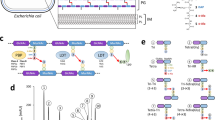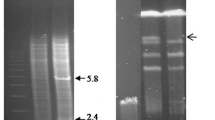Abstract
Historically seven Penicillin Binding Proteins (PBPs) have been recognised in Escherichia coli, though with recent work two more have been added. Two of the PBPs, PBP2 and PBP3 have distinct morphological roles (Spratt, 1983). PBP2 is involved in cell elongation and allows the rod shape to be maintained, while by contrast PBP3 is required for septum formation, and its inhibition leads to filamentation and lysis. Both these proteins have been demonstrated to have transpeptidase and associated transglycosylase activity (Ishino & Matsuhashi 1983. Ishino et al 1986).
Access this chapter
Tax calculation will be finalised at checkout
Purchases are for personal use only
Preview
Unable to display preview. Download preview PDF.
Similar content being viewed by others
References
Begg, K., Takasuga A., Edwards D., Dewar S., Spratt B.G., Adachi H., Ohta T., Matsuzawa H., & Donachie W.D. (1990) The balance between different peptidoglycan precursors determines whether E.coli cells will elongate or divide. J. Bact 172, 6697–6703.
Broome-Smith J.K. (1985) Construction of a mutant of E. coli that has deletions of both the Penicillin-binding Protein 5 and 6 genes. J. of General Microbiol 131, 2115–2118.
Glauner B. (1988) Separation and quantitation of muropeptides with high performance liquid chromatography. Analyt.Biochem 172, 451–464.
Ishino F., Park W., Tomioka S., Tamaki S., Takase I., Kunugita K., Matsuzawa H., Sadamitsu A., Takahisa O., Spratt B.G., & Matsuhashi M. (1986) Peptidoglycan Synthetic activities in membranes of E.coli caused by overproduction of Penicillin Binding Protein 2 and RodA protein. J.Biol.Chem. 261, 7024–7031.
Ishino F. & Matsuhashi M. (1981) Peptidoglycan synthetic enzyme activities of highly purified PBP3 in E.coli: A septum forming reaction sequence. Biochem & Biophys Research Communications pp. 905-911.
Kato J., Nishimura Y., Yamada M., Suzuki H., and Hirota Y. (1988) Gene organisation in the region containing a new gene involved in chromosome partition in E.coli J.Bact. 170, 3967–3977.
Maniatas T., Sambrook J., & Fritsch E. (1989) “Molecular Cloning a Laboratory Manual.” Cold Spring Harbour Lab Press.
Pierre J., Boisivon A., and Gutmann L. (1990) Alteration of PBP3 entails resistance to Imipenem in Listeria monocytogenes. Antimicrobial Agents and Chemotherapy. 1990 Vol.34 No.9 pp. 1695–1698.
Prentki P., & Krisch H.M. (1984) In vitro Insertional mutagenesis with a selectable DNA fragment. Gene 29, 303–313.
Russell C.D., Thaler D.S., & Dahlquist F.W. (1990) Chromosomal transformation of E.coli recD strains with linearised plasmids. J.Bact. 171, 2609–2613.
Schuster C., Dobrinski B., & Hakenbach R. (1991) Unusual septum formation in Streptococcus pnumoniae mutants with an alteration in the D,D-Carboxypeptidase Penicillin Binding Protein 3. J.Bact. 172, 6499–6505.
Spratt B.G. (1983) Penicillin-binding Proteins and the future of beta-Lactam Antibiotics. J.G. M. 129, 1247–1260.
Spratt B.G. (1977) Properties of Penicillin Binding Proteins of E.coli K12. Eur.J.Biochem. 72, 341–352.
Spratt B.G. & Pardee, A.B. (1975) Penicillin Binding Proteins and cell shape in E.coli. Nature 254, 516–517.
Author information
Authors and Affiliations
Editor information
Editors and Affiliations
Rights and permissions
Copyright information
© 1993 Springer Science+Business Media New York
About this chapter
Cite this chapter
Edwards, D.H., Donachie, W.D. (1993). Construction of a Triple Deletion of Penicillin-Binding Proteins 4, 5, and 6 in Escherichia coli . In: de Pedro, M.A., Höltje, JV., Löffelhardt, W. (eds) Bacterial Growth and Lysis. Federation of European Microbiological Societies Symposium Series, vol 65. Springer, Boston, MA. https://doi.org/10.1007/978-1-4757-9359-8_44
Download citation
DOI: https://doi.org/10.1007/978-1-4757-9359-8_44
Publisher Name: Springer, Boston, MA
Print ISBN: 978-1-4757-9361-1
Online ISBN: 978-1-4757-9359-8
eBook Packages: Springer Book Archive




